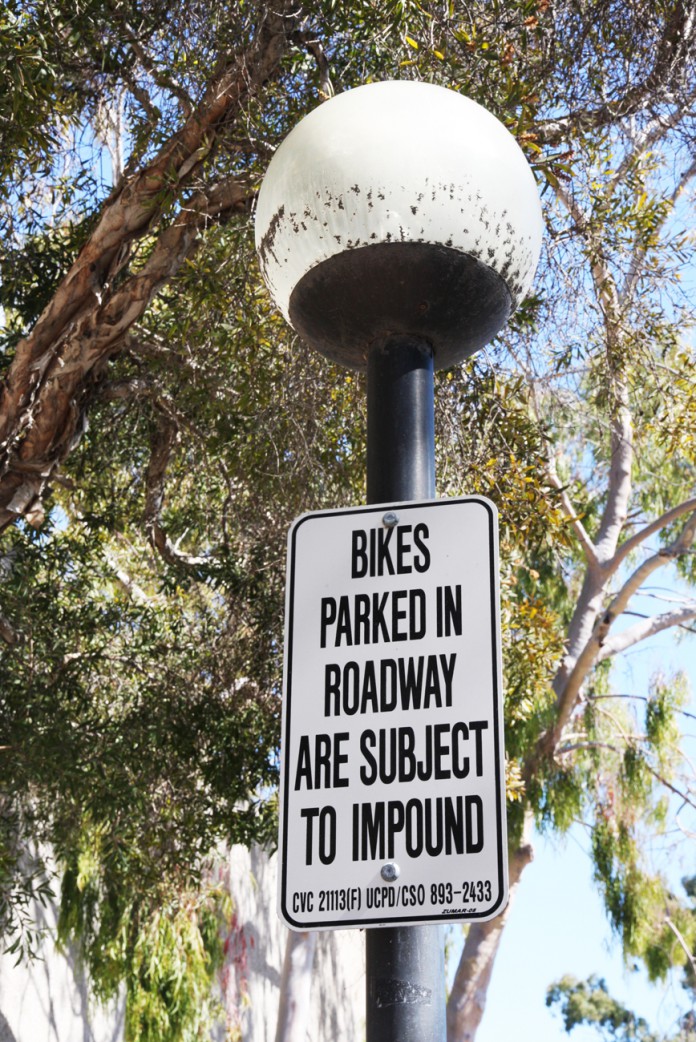Ryan Orihood
Staff Writer
Photo By: Rosana Liang, Photo Editor
Impounding bikes is a big issue on the UC Santa Barbara campus. Every day, students face this inconvenient abduction. Student bikes are taken to the Public Safety building, located at the primarily uninhabited end of campus. Students then must make the trek–ironic, since they don’t have a bike to ride there–and pay a $24 fine to get their means of transportation back.
Impounding is a hassle to many, and not just students. When I see an officer using all his might to break through a u-lock, is it worth it to them, too? Is impounding bikes a helpful and crucial campus procedure?
There are many reasons why a student would not park in a bike rack. For one thing, some older bicycles tend to retire in the racks. Many parking spaces on campus are blocked off because these souls are put to rest here. I have noticed that since fall quarter of this year, the same rusty, robbed bike frames and wheels are locked to the same racks outside the Thunderdome, among other locations.
Why haven’t these remnants been properly removed?
According to The Community Service Organization’s (CSO) page on the UCSB Police Department website, the police take responsibility for “clearing racks on campus, around the residence halls, as well as Off-campus University owned housing… this abatement process ensures that our campus is not cluttered with rusty and abandoned bicycles and/or bicycle parts.”
But there are still spots hogged by these old, useless bike parts.
It matters because bicycle racks are vital on campus. For many students, bicycles are their main means of transportation. But with few available bike racks on campus and the unanticipated large student body at UCSB, there looms a potential shortage of parking spots. This can make it difficult to properly park one’s bike and may lead to parking it illegally.
Melissa Buckley, an undergraduate Biopsychology major at UCSB, falls into this category. Due to a lab she has this quarter, she parks near Noble Hall across from the Psychology Building.
“Those bike racks are either full or close to full whenever I get there, and there are always bikes lined up when I get there,” she said.
One evening, with no other option, Buckley said she was forced to illegally park her bike.
“There have been plenty of occasions where I have parked it like that and haven’t had it impounded,” she said.
Unfortunately, the CSO caught her one time, and her bike was impounded.
There are other circumstances that account for our bike parking jobs, including how much time we have and how close a rack is to our destination. These factors play into where we are able to park our bike. Often, the most convenient place to park does not have a bike rack.
Don’t misunderstand me; I am grateful for the opportunity I have to be able to bike to campus. But I often find parking problematic.
One fall evening last quarter, I was late to a class and was going to park my bike in a rack close by. But the rack seemed to be full and past its limit. Because of my tardiness, I decided to lock it to a bench so that my bike would still be secure while I was in class.
But I came out of class to discover a CSO throwing my bike among the rest of those impounded for the day.
More bike racks would be the most logical solution to this problem. But are there other, more immediate solutions? What if these temporary instances of illegal parking were allowed? The CSO’s website states that they impound bikes based on danger level. Are these bikes really dangerous? I doubt they will come alive, break free from their bondage to a pole or tree, and wreck havoc on campus.
This isn’t Transformers; it is our college, and these temporary park jobs are not only convenient, but necessary.












Comments are closed.